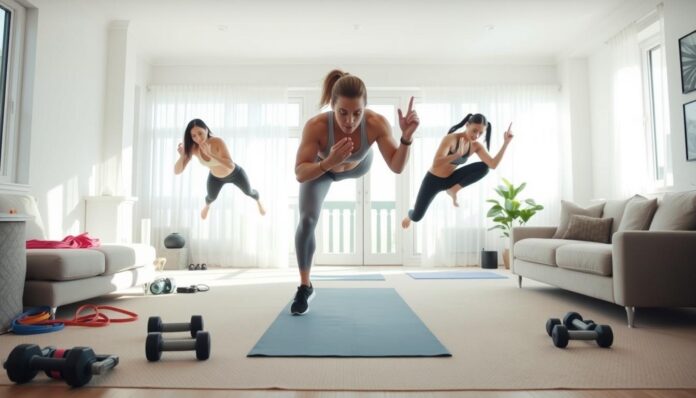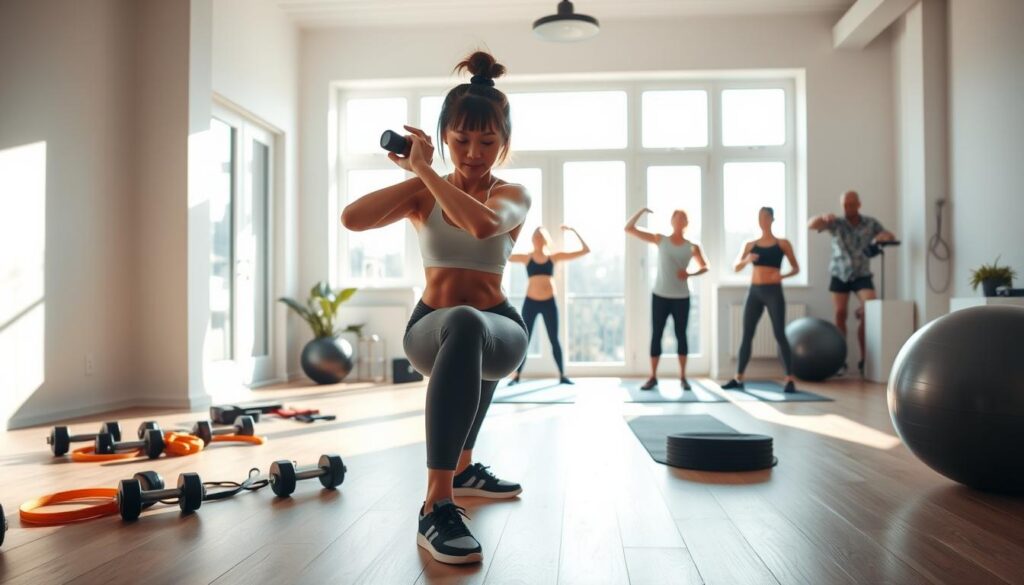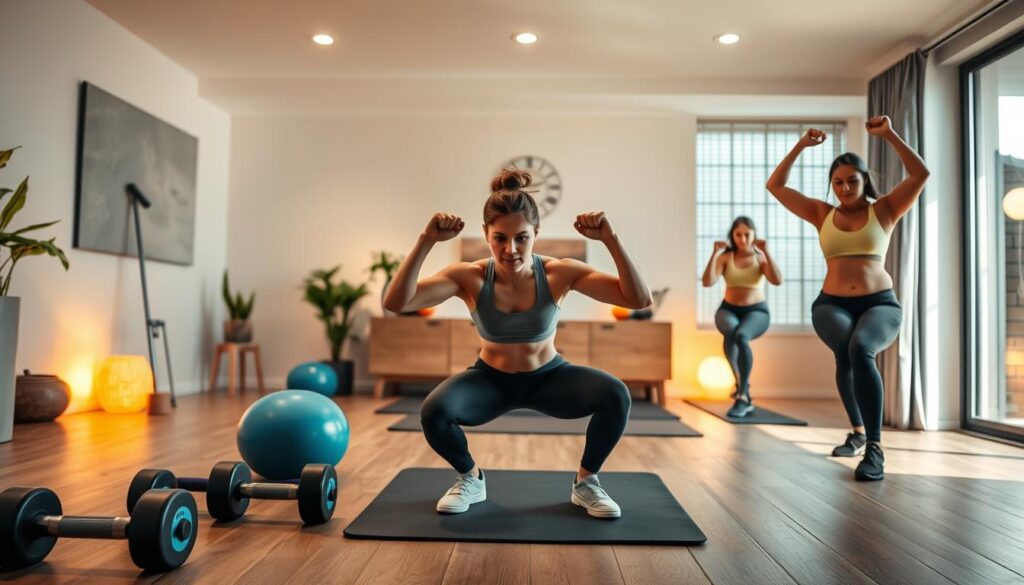Imagine coming home after a long day, feeling tired and not wanting to go to the gym. The idea of dealing with traffic or waiting for equipment at a busy gym is overwhelming. But, with your yoga mat and favorite music, you decide to work out at home instead.
In just a few minutes, you turn your living room into a personal gym. You connect with your health goals without leaving your house. This is what makes home workouts so great.
Whether you’re just starting out or have been working out for years, at-home fitness is empowering. This guide will show you different ways to work out using just your body or a little equipment. You’ll be on your way to fitness with a routine that’s all about you.
Key Takeaways
- Full body workouts at home are efficient and require little to no equipment.
- Home workout routines can be easily customized to fit your schedule.
- Engaging in at-home fitness boosts both physical and mental well-being.
- With consistency, you can achieve significant fitness results from your living room.
- Utilizing online resources can enhance your at-home training experience.
Introduction to Home Workouts
Home workouts have changed the fitness world, becoming a popular choice instead of gyms. They offer flexibility and convenience, fitting easily into your busy life. You can tailor your workouts to your liking, fitness level, and space.
Home workouts offer more than just ease. They provide a cozy space to focus on your goals, away from gym distractions. Many people now see great results with simple exercises, often needing little to no equipment.
Starting a home workout routine helps you stay consistent. It makes fitness a part of your daily life. You can fit in a workout anytime, whether it’s morning stretches or evening strength training. Home workouts are about embracing a healthier lifestyle, free from gym constraints.
Benefits of Full Body Workouts
Full body workouts have many benefits, making them a top choice for fitness enthusiasts. They allow you to work out different muscle groups in one session. This makes them perfect for those with tight schedules, helping you stay fit efficiently.
Efficiency in Workout Routines
Full body workouts give you great results in less time. They usually last 35-40 minutes, fitting well into busy lives. Exercises like squats, lunges, and push-ups work many muscles at once.
This approach boosts your athletic performance, making every minute count. Learn more about efficient workout routines that fit your lifestyle.
Improved Overall Fitness
Doing full body workouts regularly boosts your fitness a lot. They help develop muscles evenly and improve endurance. You also get better at staying stable, which is key for everyday activities.
By choosing this method, you’ll see big improvements in your fitness. It leads to a healthier, more active life.
Planning Your Full Body Workout at Home
Planning a full body workout at home needs careful thought. It helps you reach your fitness dreams. By setting clear goals, you can make a fitness plan that fits you.
Having fitness objectives keeps you focused and motivated. It helps you stay on track with your goals.
Setting Realistic Goals
Begin by setting realistic and measurable goals. Use the SMART criteria: specific, measurable, achievable, relevant, and time-bound. This makes your goals motivating and reachable.
- Specific: Define exactly what you want to achieve.
- Measurable: Establish criteria for tracking progress.
- Achievable: Ensure that your goals can be met with the resources and time you have.
- Relevant: Set objectives that truly matter to you.
- Time-bound: Set a timeline for accomplishing your goals.
By focusing on these elements, you create achievable milestones. These guide your workout efforts effectively.
Creating a Schedule
A well-structured workout schedule is key. Consistency in training is vital. It keeps you committed and on track with your goals.
- Determine the frequency of your workouts each week.
- Decide on the duration of each session, balancing intensity and recovery.
- Ensure a varied approach by targeting different muscle groups throughout the week.
With a solid fitness routine planning, you have a practical roadmap. It makes staying dedicated and achieving your goals easier.
Essential Movement Patterns for Effective Training
Knowing the key movement patterns is key for a good workout plan. Hinging and squatting exercises boost strength, mobility, and function. They also prevent injuries and improve performance.
Hinging and Squatting
Hinging and squatting are the base of any good workout. Squats work many muscles, like legs and core. They keep knees and hips healthy by spreading out the force.
Adding squatting to your routine boosts lower body strength and keeps bones strong. This is very important as we age.
The hip hinge, seen in deadlifts and kettlebell swings, strengthens the back and legs. It’s vital for safe lifting and bending. It improves flexibility and balance.
Pushing and Pulling
Pushing and pulling exercises are key for upper body strength and stability. Pushing works the chest, shoulders, and triceps. It helps with everyday tasks like opening doors.
Pulling exercises, like rows and pull-ups, strengthen the back. They help keep good posture and balance.
Carrying Techniques
Carrying techniques boost functional strength and stability. Farmer’s walks and suitcase carries improve core and grip strength. They’re useful for daily tasks like grocery shopping.
Carries enhance posture and reduce spinal injury risk. They also improve endurance.
Bodyweight Exercises for Beginners
Bodyweight exercises are a great way to get fit without spending a lot on equipment. They help you build strength, flexibility, and endurance using your own body weight. These exercises are perfect for starting your fitness journey at home, as they can be done in many places.
Introduction to Bodyweight Exercises
Bodyweight exercises are effective for all fitness levels. You can do them anywhere, indoors or outdoors. They’re flexible, allowing you to adjust your workouts to fit your goals and build confidence.
Top 10 Beginner Friendly Movements
Adding these beginner-friendly exercises to your routine can boost your strength and fitness. Each exercise comes with instructions to help you do it right:
| Exercise | Description | Benefits |
|---|---|---|
| Bodyweight Squats | Stand with feet shoulder-width apart and lower your hips back and down as if sitting in a chair. | Strengthens legs and core, improves stability. |
| Push-ups | Begin in a plank position, lower your chest to the floor, then push back up. | Enhances upper body strength and core stability. |
| Lunges | Step forward with one leg, lowering the back knee towards the ground while keeping the front knee aligned. | Increases leg strength and balance. |
| Plank | Hold your body in a straight line from head to heels, supported on your forearms and toes. | Builds core strength and stability. |
| Glute Bridges | Lie on your back with knees bent, lift your hips towards the ceiling while squeezing your glutes. | Strengthens glutes and lower back. |
| Tricep Dips | Using a sturdy chair or bench, lower and raise your body using your arms. | Tones and strengthens triceps. |
| Mountain Climbers | Start in a plank position, alternate bringing knees toward your chest quickly. | Improves cardiovascular fitness and core strength. |
| Side Plank | Lie on your side, lift your body on one elbow while keeping your hips elevated. | Enhances core stability and strength. |
| Jumping Jacks | Stand with feet together, jump while spreading your legs and arms wide, then return. | Boosts heart rate and provides a full-body workout. |
| Burpees | Start standing, drop into a plank, perform a push-up, return to the squat position, then jump up. | Combines strength and cardio, enhances overall endurance. |
Full Body HIIT Routines at Home
High-Intensity Interval Training (HIIT) is a great way to stay fit. It lets you do full body workouts in less time. This method is efficient, helping you see results fast without long workouts.
Start your HIIT routine at home with exercises that work many muscles. Try burpees, jump squats, and mountain climbers. Work hard for 20 seconds, then rest for 10. Repeat this for a few rounds to get the most out of it.
It’s important to know how to recover well. Always warm up before and cool down after your workout. Use breathing techniques and drink water to help your body recover between intense intervals.
Here’s a simple HIIT workout plan to follow:
| Exercise | Duration (seconds) | Rest (seconds) | Rounds |
|---|---|---|---|
| Burpees | 20 | 10 | 4 |
| Jump Squats | 20 | 10 | 4 |
| Mountain Climbers | 20 | 10 | 4 |
| Push-Ups | 20 | 10 | 4 |
No Equipment Workout Options
Working out without equipment lets you reach your fitness goals without any gear. Using your body weight as resistance can make your workouts intense and effective. This section will guide you on how to use bodyweight exercises to make your workouts challenging and accessible.
Harnessing the Power of Body Weight
Your body is a great tool for creating resistance. By doing bodyweight exercises, you can build strength, boost endurance, and increase flexibility. Exercises like push-ups, squats, and planks use your body weight against gravity, helping you get fit.
These movements also raise your heart rate, giving you heart health benefits along with strength training.
Effective Exercises Without Equipment
Creating a workout with no equipment can work your whole body. Here are some top exercises:
- Push-Ups: Work your chest, shoulders, and triceps.
- Bodyweight Squats: Strengthen your quads, hamstrings, and glutes.
- Planks: Improve your core and stability.
- Burpees: Mix strength and cardio for a tough workout.
- Lunges: Work your quads and glutes.
Adding these exercises to your routine will give you a well-rounded workout. Reach your fitness goals by using bodyweight exercises and following a structured plan. This way, you can challenge yourself, no matter your fitness level.
Home Gym Workouts with Minimal Equipment
Setting up a home gym can change your fitness journey. You can use just a few key pieces, like dumbbells or resistance bands. This way, you can work out your whole body with a few simple tools.
When choosing minimal equipment workouts, pick exercises that work many muscles. Dumbbells are great for squats and shoulder presses. Resistance bands are good for strength and flexibility. Using both can make your workouts more effective.
To create a good home gym, pick a dedicated space. Make sure it’s organized and free from distractions. Having your gear ready makes it easier to stick to your routine. Changing up your workouts keeps them interesting and helps you reach your fitness goals.
Exercise Videos for Home Workouts
Using exercise videos can change your home workout game. They give you clear steps and plans to boost your fitness. It’s key to find top online fitness tools to keep you motivated and on track. Learn how to pick the right virtual training to fit your fitness needs.
Finding the Best Online Resources
With so many home workout videos online, it can be hard to choose. Look for trusted sites that have different workout types and levels. Check out fitness stars on YouTube or fitness apps. They offer videos for strength, cardio, and more, to meet your fitness aims.
Read what others say and check out different channels. Also, don’t miss out on top online resources for tips and guidance.
Guided Routines for Efficiency
Following guided workout plans can make training easier. They save you time and help you reach your fitness goals. Many online resources have plans that mix strength, cardio, and flexibility.
Make sure the routines come from reliable sources with clear explanations and videos. Working with these videos can improve your skills and make workouts fun. They’re great for anyone, whether you’re new to fitness or have been doing it for years.
Full Body Workout at Home: Sample Routine
A good workout starts with the right warm-up. These exercises boost your performance and help prevent injuries. By using different warm-up methods, you prepare your body for a full body workout.
Warm-Up Techniques
Start with these exercises to get your heart racing and muscles ready:
- Jumping Jacks: 2 sets of 30 seconds
- Arm Circles: 2 sets of 15 reps each direction
- Leg Swings: 2 sets of 15 swings each leg
- Dynamic Lunges: 2 sets of 10 lunges each leg
These movements increase blood flow and improve your workout performance. They also reduce the chance of injury.
Full Body Circuit Structure
Your circuit will target all major muscle groups. Here’s a sample structure with sets, reps, and rest times:
| Exercise | Sets | Reps | Rest Time |
|---|---|---|---|
| Push-Ups | 3 | 10-15 | 30 seconds |
| Squats | 3 | 12-15 | 30 seconds |
| Plank | 3 | 30 seconds | 30 seconds |
| Mountain Climbers | 3 | 15-20 | 30 seconds |
| Bicycle Crunches | 3 | 15-20 | 30 seconds |
Doing this workout with proper form will engage your whole body. It’s a mix of warming up and a balanced circuit for a great workout.
Common Mistakes to Avoid in Home Workouts
Home workouts can be very rewarding, but there are common mistakes to watch out for. These mistakes can affect your form and recovery. Knowing about these issues is key to reaching your fitness goals.
Poor Form and Technique
One big mistake is ignoring proper form during exercises. Bad form can make your workouts less effective and even hurt you. For example, arching your back during overhead presses can stress your back and shoulders.
To avoid this, keep your spine straight and your knees slightly bent. This helps you lift weights safely.
When doing lunges, don’t take too small steps. This can strain your front knee. Try to keep your front heel two feet ahead of your back knee. This reduces the risk of injury.
Also, don’t overdo crunches, as they can hurt your back. Try exercises like Pilates or yoga’s boat pose to strengthen your core without strain.
Neglecting Recovery
Another big mistake is not taking enough rest. Rest is key for muscle growth and staying fit. The fitness world has moved away from the “no pain, no gain” idea. Now, rest and recovery are seen as important.
Experts say you should rest each muscle group for at least 48 hours. Light activities between hard workouts are also good. Mindfulness, like meditation, can help manage stress and keep you on track with your fitness goals.
For more tips on improving your home workouts, check out this resource.
Tracking Your Progress and Staying Motivated
Keeping an eye on your fitness journey is key to reaching your goals. Regularly tracking your progress lets you see what you’ve achieved and what you need to work on. Having a way to measure your progress boosts your motivation and keeps you excited about working out.
Setting Milestones
Setting milestones helps you break down big goals into smaller, doable steps. By setting clear targets, you feel a sense of pride when you reach them. Here are some tips for setting good milestones:
- Set specific goals, like lifting a certain weight or doing a certain number of workouts a month.
- Give yourself deadlines for your goals to keep you on track.
- Give yourself a reward when you hit a milestone to keep your motivation up.
Utilizing Fitness Apps
Fitness apps are great for tracking your workouts and seeing how far you’ve come. They can adjust to your needs and help you stay consistent. Many apps have features like:
- Logging your workouts to keep track of what you’ve done.
- Charts that show your progress over time.
- Tools to help you set and reach your fitness goals.
Conclusion
This guide has shown you many ways to do a full body workout at home. You can make a workout plan that fits your fitness journey. Remember, staying fit at home is a long-term goal for a healthy life.
Focus on your long-term fitness goals as you build your routine. Every workout brings you closer to your goals, even if it seems small. The tools and techniques here are meant to help you stay committed and passionate about your health.
The path to fitness is different for everyone. Enjoy the journey of working out at home. With determination and the right strategies, you’ll not only meet but exceed your health goals for a better life.
FAQ
What is a full body workout at home?
A full body workout at home targets many muscle groups in one session. It helps improve fitness without needing gym equipment.
Are home workouts effective?
Yes, home workouts are very effective. They include bodyweight exercises, HIIT, and strength training. They’re flexible and help you reach your fitness goals.
What are bodyweight exercises, and how do they benefit beginners?
Bodyweight exercises use your body weight for resistance. They’re great for beginners. They boost strength, flexibility, and endurance without equipment.
How can I create a workout schedule that fits my lifestyle?
First, figure out when you can work out. Set a realistic schedule. Mix strength and conditioning exercises. Be flexible to fit your daily life.
What types of movement patterns should I focus on in my workouts?
Focus on hinging, squatting, pushing, and pulling. These improve functional strength and athletic performance.
Can I achieve a full body workout without any equipment?
Yes, you can! Use bodyweight exercises like squats, lunges, push-ups, and planks. They provide a tough workout without equipment.
What are HIIT workouts, and how do they work for home exercise?
HIIT involves short, intense exercises followed by rest. It’s great for quick, effective workouts at home.
How can I prevent injuries during my at-home workouts?
To avoid injuries, warm up well and focus on proper form. Listen to your body and take recovery days. This lets your muscles heal and grow.
What are some effective ways to track my fitness progress?
Use fitness apps to log your workouts. Track strength, endurance, and body changes. Setting goals keeps you motivated and on track.






